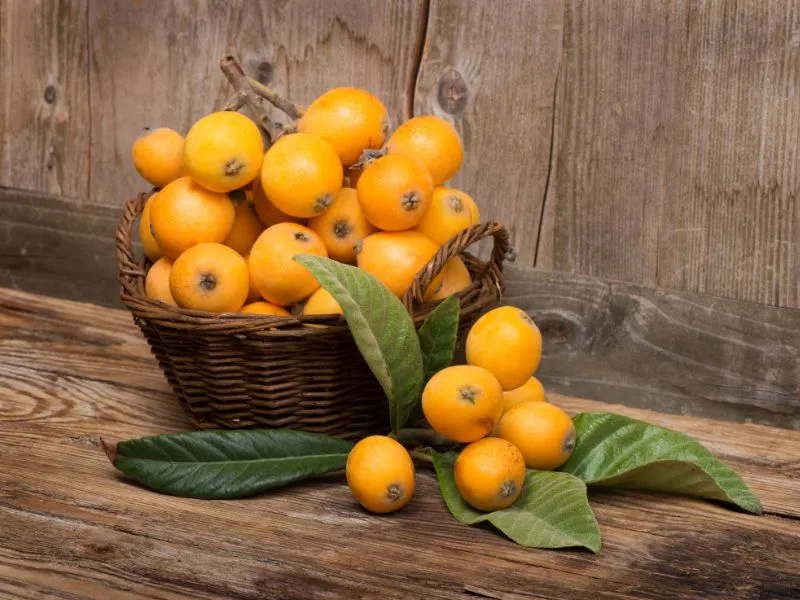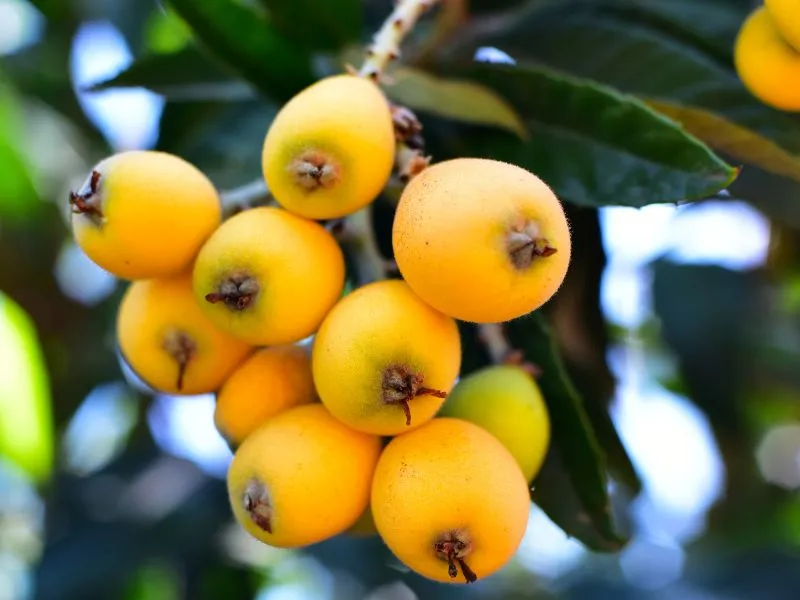Have you ever thought about the process, of how fruits come to our table? How they are planted, their development cycle, their harvesting process, and then their supply. Some species take many years, while some start producing fruits in a few years like Loquats. Growing the Loquat trees in pots is to be discussed here in detail.
Loquats, also known as Japanese plums or Chinese Plum are yellow-orangish fruit that is soft and juicy.
Loquat
- Their color is yellow and orange and can be eaten with or without the peel.
- Loquats have round, oval, or pear-like shapes.
- The flesh of Loquats is red or orange depending upon the variety of loquats and has two to three black seeds.
- The taste of Loquats is a mixture of apricot, plum, and mango. They are sweet and have a slight citrus flavor.
- The maximum height of the Loquat tree is 30 ft. but on average 10 – 15 ft.

Varieties of Loquats
Primarily, Loquats are divided into two varieties:
- Orange fleshed Loquats
- Red fleshed Loquats
Sub-varieties of Orange Fleshed Loquats
Orange fleshed loquats have a further eight varieties:
- Big Jim:
- Early Red
- Gold Nugget
- Mogi
- Mrs. Cooksey
- Strawberry
- Tanaka
- Wolfe
Sub-varieties of Red Fleshed Loquats
Red Fleshed Loquats have further six varieties:
- Advance
- Benlehr
- Champagne
- Herd’s Mammoth
- Victory
- Vista White
Use Of Loquats in Japan and China
Loquat is a fruit of Japanese and Chinese origin. In China and Japan the fruit of Loquat is used in many ways, some most popular are:
- In China, loquats are used to make portions/of syrup. They have been believed to cure cough.
- In Japan, by using the leaves of Loquats “biwa cha” has been prepared.
- Biwi Cha helps in the treatment of respiratory diseases like bronchitis and asthma.
- Biwi Cha is beneficial in treating skin problems.
How Fruit Development Takes Place In Loquats
Every fruit plant has its way of producing flowers and then fruits. The Loquats develop fruit in the following manner:
- When fall arrives i.e at the end of summer, the loquat tree starts producing flowers.
Flowers appear in the form of clusters. Each cluster has hundreds of flowers. Most of the time each cluster of flowers produces 10 – 12 loquats.
- When fruits start to appear in the clusters, it is time to check some necessary things. Like temperature and pruning if necessary.
- When the fruit ripens, it is ready to harvest. The ripened fruit is soft and juicy. Ripened Loquats are easy to remove from stems.
- After harvest, during spring and summer, the loquat tree grows again and produces flowers the next fall.
The amount of flowers and fruit is not consistent. It is dependent on several factors like temperature, humidity, and many others.
You May Also Like
HOW TO GROW BLACK RASPBERRIES FROM CUTTINGS
How to Grow Blood Oranges from Seeds
Plants To Be Planted Around Loquats
The surrounding plants influence each other to great extent. They interact with each other, exchange organic compounds via soil, and play a part in pollination.
Some plants which are great companions for Loquats are:
- Apples
- Chives
- Pears
- Lavender
- Quince
The plants that are not beneficial as companions of Loquats are:
- Walnut
- Cedar
How To Plant Loquat In a Pot
Loquat is one of those plants, which can be planted in a pot or container. To plant Loquat in a pot you need the following things:
- A 24 inches wide pot
- Potting mixture
- A Loquat Shrub
Step 1:
Take a 24 inches wide pot and place it on the surface where it will get good sunlight.
Step 2:
Fill the pot with a good-quality potting mix.
Step 3:
Make a hole inside the potting mix and by carefully removing the shrub from the container place it in the hole. Take care of roots while placing the shrub.
Step 4:
Cover the roots with soil. Press it down gently.
Step 5:
The shrub has borne the transplanting shock. To overcome it, water the plant generously. So that the plant will be well-soaked.
Step 6:
Water the plant daily or after one day at an early stage. Once it is well established, reduce it to one time a week.
Things To Take Care of While Planting Loquat in Pot
The necessary things which have to be kept in mind while planting loquat in the pot are:
- Choose good quality soil for planting loquat in the pot. The quality of soil plays an important role as the plant gets all the necessary nutrients from the soil.
- Water the plant regularly. The loquat plant needs to be watered, but it should be kept in mind that its roots should not be present in water all the time or in wet soil. So there should be drainage holes as well.
- Loquat’s roots are shallow. While planting loquat, they should be handled with ultimate care.
- The loquat tree needs maintenance like pruning, and mulching should be done and they should be fertilized properly.
- Sunlight is necessary for Loquats, but if there is too much sunlight put your loquat pot under shade.
Techniques For Good Maintenance of Loquats
The following techniques will help in good maintenance and thus the production of a good amount of Loquats:

Watering:
Properly watering the loquat tree will help in the good development of the Loquat. In the early times, water the plant daily. Later on, set water timings. If your soil is naturally wet due to rain or weather conditions in that place, don’t overwater. It will cease growth.
Mulching:
This is a method in which you spread a layer of material such as sugarcane straw, pea straw, or bark chips around the plant.
Mulching helps in the following ways:
- It helps the soil to absorb moisture.
- Improves fertility and soil health.
- Ceases the growth of weed.
Fertilizing:
Fertilizing the plant at the right time enhances its growth of the plant. Loquat trees need to be fertilized three times a year.
The perfect times for Loquat to be fertilized are:
- Fall
- Winter
- Autumn
For fertilizers, the safety precautions are not to use fertilizers having high nitrogen content. It will lessen the flowering and fruit as well.
If your plant has good and excessive growth, it means it doesn’t need fertilizer three times a year. Then you should use fertilizer one or two times a year.
Also, Read
How to Grow Jujube Plant from Seed
How to Grow Banana Passion Fruit from Seed
Pruning:
Pruning is the process where you remove the extra stems or branches from the plant. It has the following benefits:
- It will remove dead and infected branches.
- The ripened fruit will get full sunlight and energy
Thinning Loquats:
Thinning loquats means removing some immature fruits. It is necessary when the plant produces excessive fruit.
By removing some clusters, you can thin the loquat. It will help the other fruit to grow effectively. Otherwise, the fruit will be large in number but very small in size.
Loquat Spacing During Plantation:
During planting, the space among loquat trees should be considered. If loquats are planted too close to each other, it will stress and overcrowd them and they will not grow effectively.
Loquat trees should be planted 15 ft. apart from each other.
Weather Conditions for Loquats:
- Adaptable regions for Loquats are subtropical or mild-winter regions.
- Loquats can’t survive in too hot or too cold weather.
- The optimum temperature for flowers is 12° F, while the optimum temperature for mature trees is 26°F.
- Hot weather results in leaf scorch in Loquats.
- Loquats can bear a humid environment, but if the airflow is not good or restricted, it may result in fungal infections.
Harvesting of Loquats:
The Loquats are ready to harvest i.e fully ripened after 90 days of flowers. The best thing about Loquats is that all of the fruit ripens at the same time. If you delay the harvesting process, it will get messy because the fruit will overripe and start falling from the tree.
How would you know that fruit is ripened? The following factors will give you an indication of harvesting:
- The ripened fruit is brighter in color than the unripened fruit.
- When fruit is ripened and ready to harvest, it is soft and can easily be removed from branches.
You can cut full clusters from the tree during the harvesting of Loquats.
Storing of Loquats:
As all the fruits on Loquat trees are fully ripened at once, there are chances that they will spoil soon. In the refrigerator, it will stay for one-week maximum.
You can store loquats in various ways. If you intend to store Loquats, you can remove loquats when they are not fully ripened.
In the following ways you can store loquats:
- You can freeze the loquat fruit as it is in the freezer by placing them on a tray. After defrosting, they will be soft and mushy. They can be used in tarts, muffins, and making jellies, and jams.
- To preserve the loquat flavor for a year, you can make jam.
- You can use stored loquats in desserts.
- By removing seeds, sauce, and loquats, syrups can be prepared.
- Wines and Juices can also be made from Loquats.
Disease Control in Loquats:
The most common diseases in Loquats are:
- Leaf Tip Burn
- Fire Blight
- Aphids
- Leaf Spot
These plant diseases can be controlled in the following ways:
Leaf Tip Burn and Its Control:
Leaf Tip Burn is the condition in which the leaves turn brown and burn due to hot weather. It happens when the temperature rises higher than the optimum temperature.
To control and avoid Leaf Tip Burn it is necessary to water the plant regularly and if loquats are planted in a pot, place the pot in a shaded area during extreme heat.
Fire Blight:
Fire Blight is a bacterial infection that results in the formation of cankers. The branches and fruits turn black and eventually die.
To control the condition, pruning can be done and copper spray should be used.
Leaf Spot:
Due to leaf spots, patches start appearing on the leaves and they become dry. It happens due to humidity and restricted airflow.
It can be cured by fungicide (broad spectrum) and pruning will also help.
Pest Control in Loquats:
Two pests that affect the loquats are:
- Scale Insects
- Fruit Flies
Scale Insects:
The solution for scale insects is the application of horticulture oil. It will cover all the insects and prevent the fruit from spoiling.
The drawback of horticulture oil is once it wears off, there are chances of infection. So, it should be regularly applied.
Fruit Flies:
Preventing the fruit from fruit flies is quite tough. Fruit flies are difficult to handle because once their maggots enter the fruit, they will surely spoil it.
The ways to prevent fruit flies are:
- Clean the fallen fruit immediately. So that fruit flies don’t inhabitants there.
- Use a fine mesh bag over the fruits.
- Spray the plant with chemicals to avoid fruit flies.
References
https://www.epicgardening.com/loquat-tree/
https://www.quora.com/Can-you-successfully-grow-loquats-in-a-container

